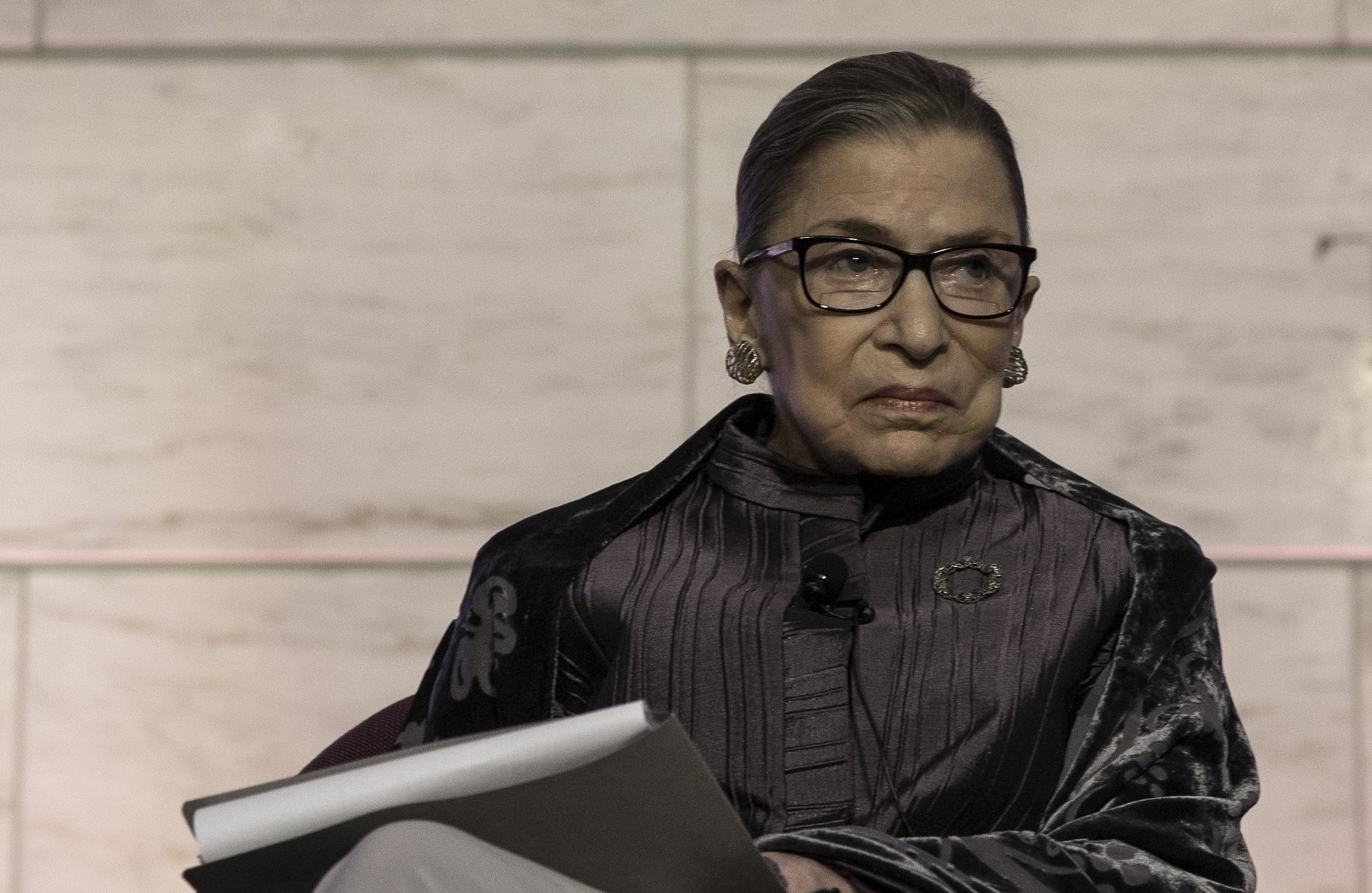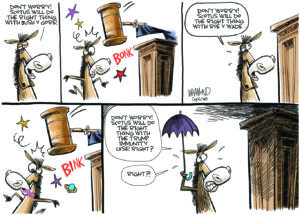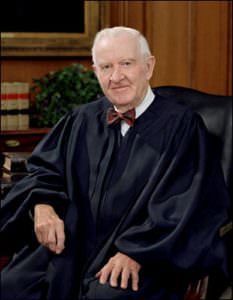If Ruth Bader Ginsburg Can’t Hold On
The 86-year-old’s health struggles have become the focal point of anyone concerned with the future of the Supreme Court. Flickr / National Museum of American History Smithsonian Institute
Flickr / National Museum of American History Smithsonian Institute
When it comes to Supreme Court Justice Ruth Bader Ginsburg, there’s one thing the Trump administration shares with many liberals and progressives: To one degree or another, they’re all engaged in a ritualized kind of “deathwatch.”
As unsettling and morbid as that sounds, that’s where we are, and we might as well acknowledge it, even at the risk of being labeled politically incorrect. The stakes are simply too great to ignore what the loss of Ginsburg could portend.
I am by no means the first commentator to invoke such ghoulish imagery about RBG, as the diminutive jurist is often referred to by fans and foes alike. Vanity Fair reporter Tina Nguyen bluntly claimed in a January column that the White House was in death-watch mode, preparing to name Ginsburg’s successor in the event “the liberal hero should depart the court, for whatever reason.”
The left’s fixation on Ginsburg is no less intense, though the impetus behind it is starkly different. Progressives have been monitoring the health of the 86-year-old justice for several years, during which she has endured four bouts of cancer. In 1999, she underwent surgery for colorectal cancer. Ten years later, she had surgery for a pancreatic malignancy. In December 2018, she was operated on for lung cancer, causing her to miss a month of oral arguments on the bench.
On Aug. 23, the Supreme Court’s public-information office issued a press release, announcing that Ginsburg had completed a three-week course of radiation at Memorial Sloan Kettering Medical Center in New York City for a new tumor on her pancreas.
No one is more acutely aware of the macabre parlor game involving her possible demise than Ginsburg, who continues to weather the speculation with wit, grit and a graceful sense of irony. In an interview with NPR in July, she told an anecdote about the late ultra-conservative Republican Sen. Jim Bunning of Kentucky, who had been a star major league baseball pitcher before entering politics. “There was a senator,” she said, without mentioning Bunning by name. “I think it was after my [first diagnosis of] pancreatic cancer, who announced with great glee that I was going to be dead within six months. That senator … is now himself dead, and I am very much alive.”
Indeed, she is. The court’s recent press release advised optimistically that Ginsburg’s “tumor was treated definitively and there is no evidence of disease elsewhere in the body.”
Since finishing her latest round of treatment, Ginsburg has resumed her busy summer schedule. She appeared at the Buffalo campus of the State University of New York on Aug. 26 to accept an honorary law degree. And on Aug. 31, she gave a talk about her memoir, “My Own Words,” at the National Books Festival in Washington, D.C., assuring her audience, “I am on my way to being very well.”
Still, there’s no discounting the heavy hand of time, and no underestimating the impact Ginsburg’s departure—whenever it takes place—will have on the future of the Supreme Court and American law.
Ginsburg has been a champion of individual rights throughout her life and career. After graduating from Columbia University Law School, she taught law at Rutgers for nearly a decade, and in 1972, she founded the ACLU’s Women’s Rights Project. From 1973 to 1978, as the project’s director, she argued six women’s rights appeals in the Supreme Court. Among her victories was Frontiero v. Richardson, which outlawed sex discrimination in the provision of benefits to military spouses, requiring the spouses of service women to receive the same rental allowances, health insurance coverage and other forms of assistance as the spouses of military men.
Ginsburg was nominated to the U.S. Court of Appeals for the District of Columbia by President Jimmy Carter in 1980. In 1993, President Bill Clinton chose her to replace Justice Byron White on the Supreme Court. She was subsequently confirmed by the Senate on a vote of 96-3, a margin of approval unthinkable in today’s hyper-partisan environment. Once sworn in, she became only the second woman, after Justice Sandra Day O’Connor, to sit on the high court.
Since taking her place on the Supreme Court, Ginsburg has established herself as one of the leading liberal justices of the modern era. Some court observers rank her alongside such legends as Louis Brandeis, John Marshall Harlan, Earl Warren, William Brennan and Thurgood Marshall.
Unfortunately for Ginsburg, she has toiled in large measure on a tribunal dominated by judicial conservatives. As a result, while she has authored some important majority opinions—such as her 1996 ruling overturning the Virginia Military Institute’s male-only admissions policy (United States v. Virginia), and a 1999 decision (Olmstead v. L.C.) that bolstered the rights of the mentally infirm under the Americans with Disabilities Act—she is better known for her dissenting opinions.
Ginsburg was on the losing side in Bush v. Gore (2000), in which the Supreme Court effectively crowned George W. Bush as the nation’s 43rd commander in chief. In dissent, she all but accused the majority of engineering a judicial coup d’état, writing: “The Court’s conclusion that a constitutionally adequate recount is impractical is a prophecy the Court’s own judgment will not allow to be tested. Such an untested prophecy should not decide the Presidency of the United States.”
The justice has also issued impassioned dissents in such hot-button 5-4 cases as:
- Ledbetter v. Goodyear Tire & Rubber Co. (2007), which severely restricted the right of female workers to file pay equity lawsuits under Title VII of the Civil Rights Act of 1964. (The majority’s ruling was later overturned by the Lilly Ledbetter Fair Pay Act of 2009.)
- Shelby County v. Holder (2013), which gutted the Voting Rights Act, and
- Burwell v. Hobby Lobby (2014), which permitted closely held corporations to withhold health insurance coverage for birth control from female employees on religious grounds.
On occasion, when she has found herself in the majority in significant cases, but was not assigned to write court’s primary opinion, she has penned concurrences to uphold such principles as Obamacare’s individual mandate (National Federeration of Independent Business v. Sevelius, 2012) and the rights of women to abortion (Whole Woman’s Health v. Hellerstedt, 2016).
Ginsburg has also been unusually vocal outside the courtroom, incurring conservative blowback for openly criticizing President Trump, calling him a “faker” before the 2016 election and suggesting in a 2017 BBC interview that the country wasn’t “experiencing the best of times” under his leadership.
When Ginsburg turns 87 in March, she will become the fourth oldest sitting justice in U.S. history, behind only Roger Taney, who died in office at 87 years, seven months; John Paul Stevens, who stepped down at 90 years, two months; and Oliver Wendell Holmes, Jr., who served until he was 90 years, 10 months old.
Just how long can RBG hang on? In her eulogy of Stevens, who passed away in July at age 99, she remarked that she hoped to remain on the bench as long as her departed colleague.
Achieving that goal would carry Ginsburg beyond the next presidential election. Should Trump be voted out of office, a Democratic president would get to name not only Ginsburg’s replacement, but most likely Justice Stephen Breyer’s successor as well, given that Breyer celebrated his 81st birthday on Aug. 3.
If Trump is reelected, or worse, Ginsburg otherwise leaves the bench before the election, the Supreme Court would lurch even more decidedly to the right. According to Axios, Trump is “saving” Ginsburg’s slot for 7th Circuit Court of Appeals Judge Amy Barrett. A staunch supporter of gun rights, Barrett is a devout Catholic and a favorite of social conservatives, who see her as delivering the long-sought final vote needed to overturn Roe v. Wade.
Small wonder, therefore, that the country remains on RBG death watch. The weight of the Constitution in no small sense rests upon Ginsburg’s slender shoulders. Here’s wishing her the best of good health for as long as humanly possible.
Your support matters…Independent journalism is under threat and overshadowed by heavily funded mainstream media.
You can help level the playing field. Become a member.
Your tax-deductible contribution keeps us digging beneath the headlines to give you thought-provoking, investigative reporting and analysis that unearths what's really happening- without compromise.
Give today to support our courageous, independent journalists.









You need to be a supporter to comment.
There are currently no responses to this article.
Be the first to respond.